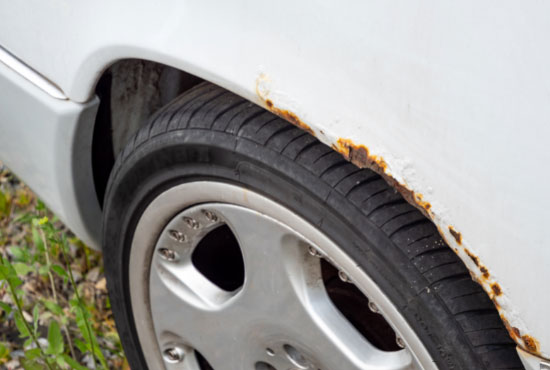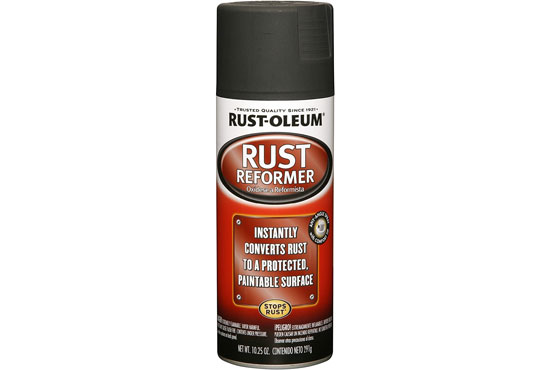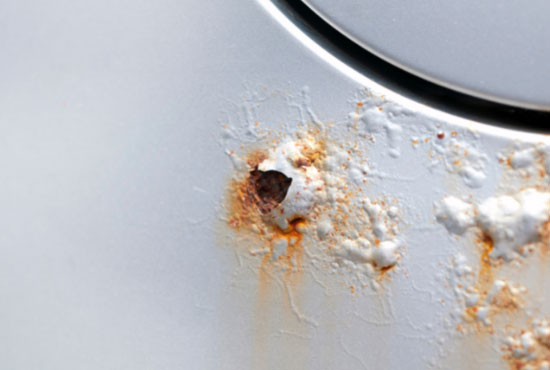Rust is one of the worst things that happen to an automobile body. Rust is aggressive, it deteriorates and damages metal to the point that the metal will finally become useless. When you see the evidence of rust starting on your vehicle your heart sinks into your stomach, and then you start to think about what you can do to get rid of it and stop it from progressing any farther.
The tried-and-true method of removing rust from metal is to remove the paint from the metal and then use sandpaper to remove the rust. Sanding is effective at rust removal but it is also time-consuming and unfortunately, if the sanding is not done correctly, it can cause a great deal of damage to the vehicle.
The purpose of this guide is to help you understand rust, how it forms, and the different choices you have in removal and protection from future rust.
What is Rust?

Most people can recognize rust when they see it. It is a reddish-looking place on metal that appears to be flaky or falling apart. Rust is actually what happens to metal when oxygen and water are introduced to it. When metal is exposed to oxygen and water it oxidizes. If a metal surface is not protected from exposure to rain and moisture caused by high humidity or other sources then it will develop a rust condition.
Types of Rust
Many people assume that rust is rust, but actually, there are three types of rust, and how you treat or prevent the types differs slightly.
Surface rust happens when the paint is scratched so moisture gets to a small section of the metal body. It can occur anywhere the paint is compromised nicked or peeled from the car. The application of touch-up paint on areas like this can prevent this type of rust from forming or damaging your vehicle.
Scale rust is the rust that has been on the metal long enough to put it. You will see a lot of scale rust in places coast to the coast where there is a lot of salt in the air. The salt in the water and air enhances the rusting process and makes pitting happen faster. This type of rust will eventually compromise the integrity of the metal and cause irreparable damage.
Penetrating rust is the advanced rust that has already started to eat away at the metal and cause visible damage like holes in the metal. Once penetrating rust has begun the metal is no longer repairable and must be replaced to stop further contamination of other components of the vehicle.
Read More>> How to Remove Clear Coat From a Car
Removing Rust without Sanding from a Car

To most people, the idea of removing rust without having to spend hours sanding the metal is a new one. It is possible to do, and often this type of removal can save you both time and money.
There are chemical rust removers that can be applied to help you stop rust from damaging your vehicle. These substances often have ingredients like hydrochloric acid, phosphoric, and oxalic so you need to use them with care and take extra precautions to protect your eyes and skin while you are using them.
There are also chemical substances that are designed to convert rust and change it so it becomes a protective barrier instead of a damaging condition. You can get these items in liquids, gels, and sprays.
Lists of Materials Needed
- Protective eyewear
- Disposable gloves
- Mask or respirator
- Brush, roller, or sprayer to apply the substance
- Water to flush away the rust remover or rust converter
- Dry cloth
- Rust inhibitor
Prepare The Surface
Before you apply the rust remover or the rust converter you must prepare the area it is going to be applied. Wash the area thoroughly to remove any dirt or grime. Rinse the area and then dry the area completely.
Apply The Product
You will apply the product you have chosen by following the manufacturer’s instructions. It is very important that you do not mix this chemical with any other chemical, and that you do not deviate from the step-by-step instructions provided with the container of rust inhibitor.
Wait Several Hours
Each rust inhibitor or converter will need to be left on the surface of the metal for a specific amount of time. You may need to leave the substance in place for as long as several hours. Read the manufacturer’s instructions carefully to discern the amount of time it will take for the product to start to be effective on the rust.
Rinse and Dry
When the product has been on the metal for the specified amount of time you will need clean water to rinse it off of the vehicle. Be sure to rinse it completely off of the metal so no traces are left. After you are certain it is completely rinsed away you will want to use a dry cloth or towel and dry the area completely.
Apply a Rust Inhibitor
After you have the area totally dry you need to apply a rust inhibitor that will prevent future rust from forming in the same area. You will also want to paint the area and seal it with a sealing agent to stop moisture and oxygen from having access to the metal.
The Pros of Rust Removing Agents
- The removers and converters work much faster than the old sand and scrape methods.
- Sanding the rust away is a lot more labor-intensive than applying a chemical remover and waiting for a little while.
- When you are sanding you can sand too much and cause the metal to be damaged or thinned too much. The chemical removers and converters are not likely to cause any damage like that to the metal they are applied to.
- Many of these substances have primer included in their formulas so they cover and protect the metal from future rust exposure.
- Most people can use these items at home and do not have to hire a paint and body shop professional to do the rust removal.
Read More>> How to Remove Spray Paint From Metal
The Drawbacks of Using Rust Removers
There are good and bad points to everything. The rust removers and converters may save you time, money, and effort, but they do have a few drawbacks you need to consider before you apply them.
- They need to be used on a surface that you plan to protect with paint and a clear coat.
- They can cause discoloration of the area and of any painted area they come into contact with.
- If your vehicle has a large amount of rust, you will need a lot of the products to treat it, and this can add up to a large amount of money.
- Using corrosive chemicals is dangerous and needs to be done away from children or pets, and in an area that is well-ventilated by someone who has prepared themselves to prevent any possible exposure.
Tips for Rust Prevention from a Car

It has been said that an ounce of prevention is worth a pound of cure, and when you are talking about rust this statement is very true. If you can prevent rust from happening you will have fewer headaches, less work, and less damage to your vehicle.
Cover the Vehicle
One of the best preventive measures is to cover the vehicle and protect it from moisture exposure and possible scratches or paint damage. You can park the vehicle in a garage or use a car cover that slips over the vehicle. The most effective method of protection is to park the car indoors and cover it.
Keep it Clean
Washing and waxing your car is one of the best protection you can give it. Wash away all dirt or grime that could have rough particulates that could damage your clear coat or get to your metal. After you wash the vehicle dry it carefully and apply a good wax coating. The wax makes the exterior shine but it also provides a protective layer stopping moisture and oxygen from getting past the paint.
If you live in an area where salt is in the air it is more important to keep the vehicle washed so you wash away the salt that can be corrosive. This is also true of areas where the roads have to be salted to prevent ice and snow build-up.
Touch up Paint
Keep touch-up paint on hand. Anytime you see an area where the paint has been scratched or damaged use the touch-up pen to immediately form a protective barrier against rust. Make a habit of inspecting your vehicle for any dings, dents, scratches, or possible problem areas.
